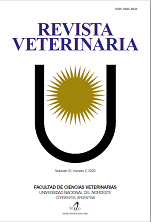Mastitis in Holstein cows and associated factors in dairy farms in Córdoba, Argentina
DOI:
https://doi.org/10.30972/vet.3124729Keywords:
cows, California mastitis test, udder hygiene, teat conditionAbstract
The objective of this study was to estimate the incidence of clinical mastitis (CM) in dairy farms and identify individual factors associated with these new episodes. Nine semipastoral dairy farms applying mastitis control and prevention measures were included and visited twice with an interval of 15 days. A random sample of cows was selected in the first visit and monitored during the following 15 days for the identification of new cases of CM. The incidence was determined as the ratio between the number of new CM cases during the follow-up period and the number of healthy cows at the first visit. The risk factors evaluated at cow level were udder hygiene, distance to the floor of the anterior quarter teat, parity and days in milk; at quarter level was evaluated the leaking milk, teat skin condition, presence of ring and hyperkeratosis and subclinical mastitis using the California Mastitis Test (CMT). A generalized mixed linear model was adjusted to evaluate the association between the factors surveyed and a new CM case. A total of 990 cows were analyzed and 62 (6.7%, 95% CI 5.0- 8.3) new cases of CM were identified. The factors associated to a new case of clinical mastitis in the final model were days in milking, udder hygiene and CMT level. Cows with very dirty udders (level 4) and CMT result ≥2 in at least one quarter showed odds ratio (OR) values of 2.56 (1.19-5.5) and 3.29 (1.5-7.2), respectively. Cow attributes identified as associated may be risk indicators for specific mammary health management in the dairy herd.Downloads
References
Barkema HW et al. 1999. Management style and its association with bulk milk somatic cell count and incidence rate of clinical mastitis. J Dairy Sci 82: 1655-1663.
Barkema HW et al. 1998. Management practices associated with low, medium, and high somatic cell counts in bulk milk. J Dairy Sci 81: 1917-1927.
Bartlett PC, Miller GY, Lance SE, Heider LE. 1992. Environmental and managerial determinants of somatic cell counts and clinical mastitis incidence in Ohio dairy herds. Prev Vet Med 14: 195-207.
Breen JE, Green MJ, Bradley AJ. 2009. Quarter and cow risk factors associated with the occurrence of clinical mastitis in dairy cows in the United Kingdom. J Dairy Sci 92: 2551-2561.
DiRienzo JA et al. InfoStat versión 2018, Grupo InfoStat, FCA, Universidad Nacional de Córdoba, Argentina, http://www.infostat.com.ar.
Gleeson DE, Meaney WJ, O’Callagham EJ, Rath MV. 2004. Effect of teat hyperkeratosis on somatic cell counts of dairy cows. Int J Appl Res Vet 2: 115-122.
Green MJ, Bradley AJ, Medley GF, Browne WJ. 2007. Cow, farm, and management factors during the dry period that determine the rate of clinical mastitis after calving. J Dairy Sci 90: 3764-3776.
Halasa T, Nielen M, Huirne R, Hogeveen H. 2009. Stochastic bio-economic model of bovine intramammary infection. Livest Sci 124: 295-305.
Hogeveen H, Huijps K, Lam T. 2011. Economic aspects of mastitis: new developments. N Z Vet J 59: 16-23.
Leelahapongsathon K, Schukken YH, Suriyasathaporn W. 2014. Quarter, cow, and farm risk factors for intramammary infections with major pathogens relative to minor pathogens in Thai dairy cows. Trop Anim Health Prod 46: 1067-1078.
Llorca J, Fariñas C, Delgado RM. 2000. Fracción atribuible poblacional: cálculo e interpretación. Gac Sanit 15: 61-67.
Neave FK, Dodd FH, Kingwill RG, Westgarth DR. 1969. Control of mastitis in the dairy herd by hygiene and management. J Dairy Sci 52: 696-707.
Neijenhuis F, Barkema HW, Hogeveen H, Noordhuizen JP. 2000. Classification and longitudinal examination of callused teat ends in dairy cows. J Dairy Sci 83: 2795-2804.
National Mastitis Council (NMC). 2003. Current concepts of bovine mastitis (Bramley A.J.), 4th ed., Madison, USA.
Olde RG, Barkema HW, Kelton DF, Scholl DT. 2008. Incidence rate of clinical mastitis on Canadian dairy farms. J Dairy Sci 91: 1366-1377.
Oliveira CS. 2015. Cow-specific risk factors for clinical mastitis in Brazilian dairy cattle. Prev Vet Med 121: 297-305.
Pantoja JC, Almeida AP, Santos B, Rossi RS. 2016. An investigation of risk factors for two successive cases of clinical mastitis in the same lactation. Livest Sci 194: 10-16.
Peeler EJ et al. 2000. Risk factors associated with clinical mastitis in low somatic cell count British dairy herds. J Dairy Sci 83: 2464-2472.
Reneau JK, Seykora AJ, Heins BJ. 2003. Relationship of cow hygiene scores and SCC. Proc Natl Mast Coun (Madison, WI), pages 362-363.
Richardet M et al. 2016. Magnitud y variación de la mastitis clínica y sus costos asociados en rodeos lecheros de Argentina. Arch Med Vet 48: 153-158.
Ruegg PL. 2006. The role of hygiene in efficient milking. WCDS Advances in Dairy Technology 18: 285-293.
Santanna AC, Paranhos MJ. 2011. The relationship between dairy cow hygiene and somatic cell count in milk. J Dairy Sci 94: 3835-3844.
Schreiner DA, Ruegg PL. 2003. Relationship between udder and leg hygiene scores and subclinical mastitis. J Dairy Sci 86: 3460-3465.
Steeneveld W et al. 2008. The influence of cow factors on the incidence of clinical mastitis in dairy cows. J Dairy Sci 91: 1391-1392.
Thrusfield M. 2007. Veterinary Epidemiology, 3rd ed., Blackwell Science, Oxford, UK, 593 p.
Downloads
Published
How to Cite
Issue
Section
License
Copyright (c) 2021 C. Vissio, M. Pereyra, M. Lamberti, C. Bonetto, A. Larriestra

This work is licensed under a Creative Commons Attribution-NonCommercial 4.0 International License.
Revista Veterinaria (Rev. Vet.) maintains a commitment to the policies of Open Access to scientific information, as it considers that both scientific publications as well as research investigations funded by public resources should circulate freely without restrictions. Revista Veterinaria (Rev. Vet.) ratifies the Open Access model in which scientific publications are made freely available at no cost online.











.jpg)
.jpg)



